
Our list debuted in 2020 with the thought that it would take a few years for any solid movement to happen. However, as we all witnessed in 2021, Shohei Ohtani just had perhaps the greatest season in baseball history.
That being said, check below to see the updated Top 10 and how far Ohtani moved up. Hopefully, this can spur up a good debate on multiple fronts.
10. Masanori Murakami (San Francisco Giants 1964-65)

This top-10 list wouldn’t be complete without the one who started it all. At Shea Stadium, September 1, 1964, pitching for the San Francisco Giants, Murakami made history as he became the first Japanese player to appear in MLB. He entered in the eighth inning and fanned the first batter he faced. After relenting a single, Murakami struck out the next two hitters he faced. The left-handed sidewinder pitched to a career 3.43 ERA and 100 strikeouts over 89.1 innings. Even though he pitched only two seasons (1964-65) in the states, he proved Japanese players could play in the bigs.
9. Kenta Maeda (Los Angeles Dodgers 2016-19; Minnesota Twins (2020-present)
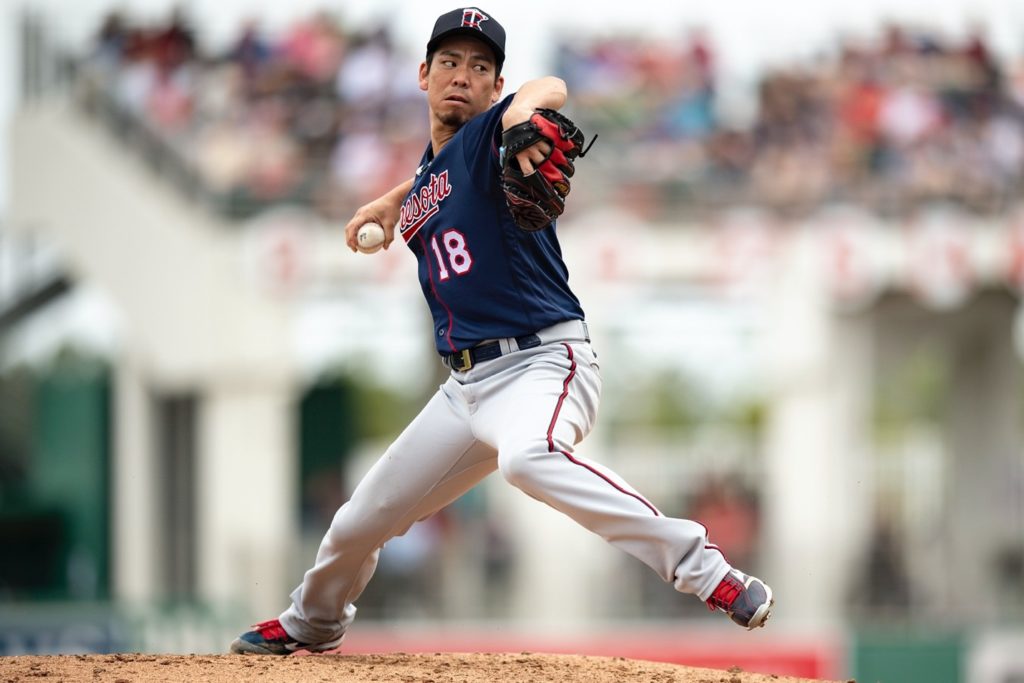
After a strong rookie campaign in which he pitched to a 3.48 ERA over 32 starts, Maeda has bounced between the rotation and bullpen since his sophomore season.
In the Postseason with the Dodgers, Maeda proved to be a true weapon out of the bullpen, pitching to a 1.80 ERA as a reliever.
8. Hiroki Kuroda (Los Angeles Dodgers 2008-2011; New York Yankees 2012-14)
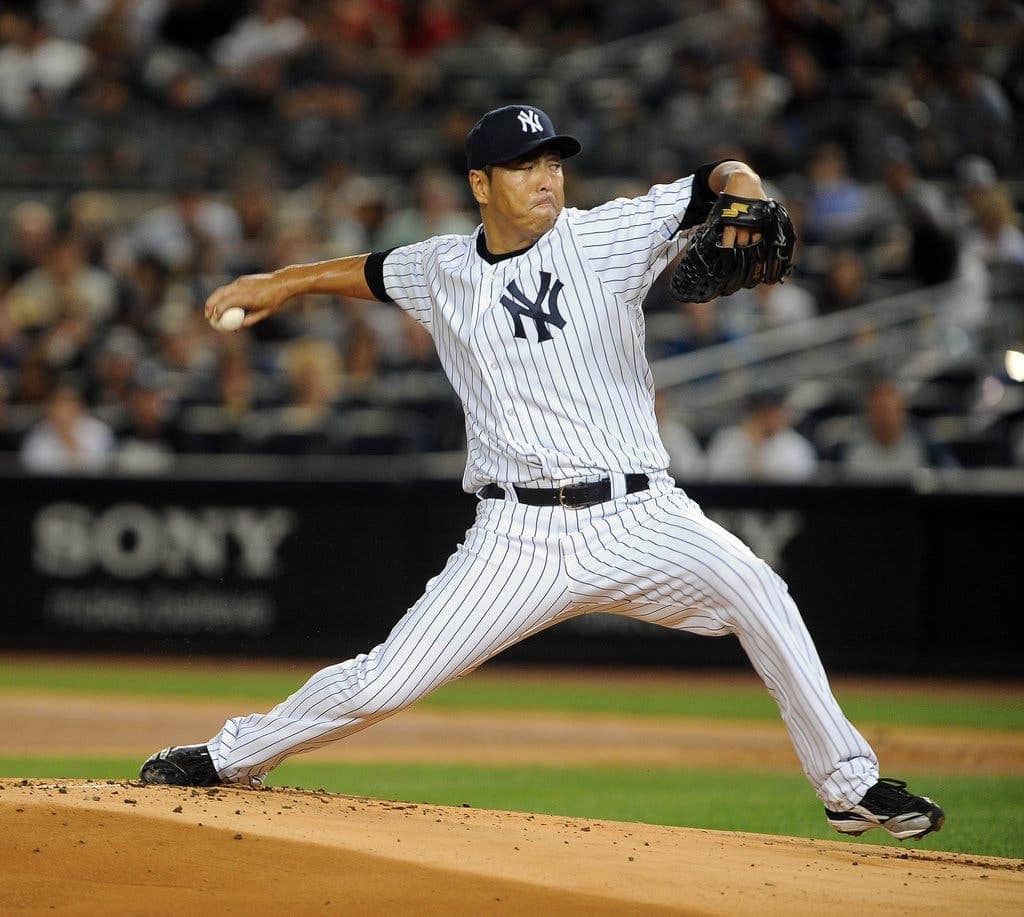
Throughout Kuroda’s Major League career, he was a model of consistency. He pitched between a 3.07 and 3.76 ERA during all seven years of service. Kuroda’s best single-game performance came in his rookie year against the Braves when he threw a “Maddux” (shutout on fewer than 100 pitches) and allowed just one hit and no walks with six punchouts. The lone hit came in the eighth inning.
7. Yu Darvish (Texas Rangers 2012-17; Los Angeles Dodgers 2017; Chicago Cubs 2018-present)

The most unique aspect of Darvish’s game is his arsenal. With his latest invention of a pitch he calls the “supreme,” the right-hander allegedly has 11 offerings at his disposal. Even though Darvish has had an up-and-down career, including a tough go in the postseason, he still has been able to collect many accolades along the way. The four-time All-Star led the A.L. in strikeouts in 2013 with 277—finishing second in Cy Young voting—and is also the fastest pitcher in MLB history to reach 500 and 1,000 strikeouts.
6. Koji Uehara (Baltimore Orioles 2009-2011; Texas Rangers 2012; Boston Red Sox 2013-16; Chicago Cubs 2017)
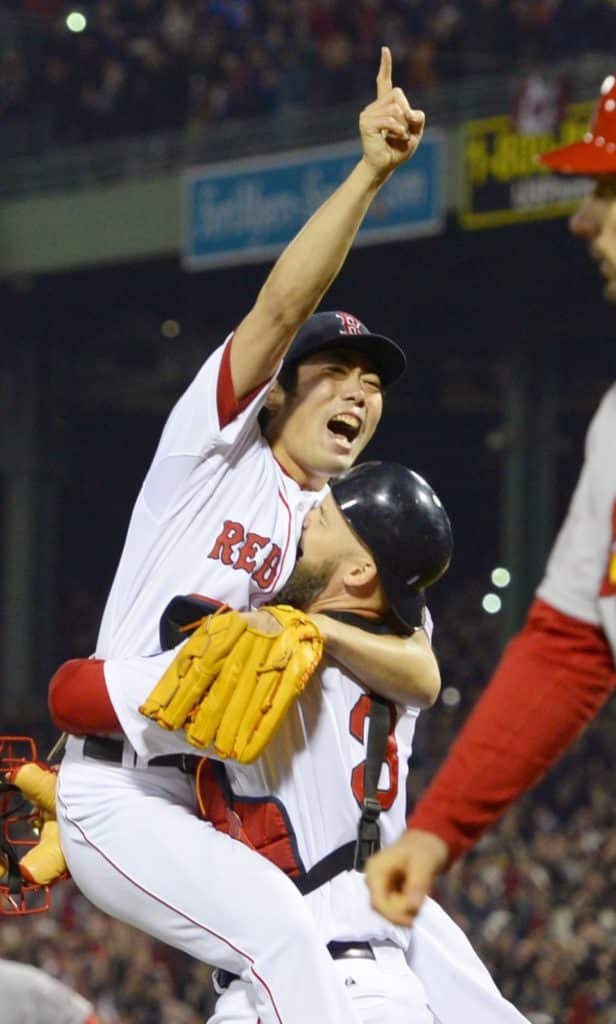
Uehara began his career as a starter in 2009 but realized his talents would be better utilized from the bullpen. In 2013, Uehara had one of the best seasons on record by a reliever. He pitched to a 1.09 ERA and 0.56 WHIP. Additionally, he retired 37 hitters in-a-row, falling four outs short of the record. During the Postseason, Uehara compiled seven saves during Boston’s 2013 title run and secured the last out in Game 6 of the clinching victory over St. Louis. Uehara finished his MLB career with the best K/BB ratio, 7.94, in history among qualified relievers.
5. Masahiro Tanaka (New York Yankees 2014-present)
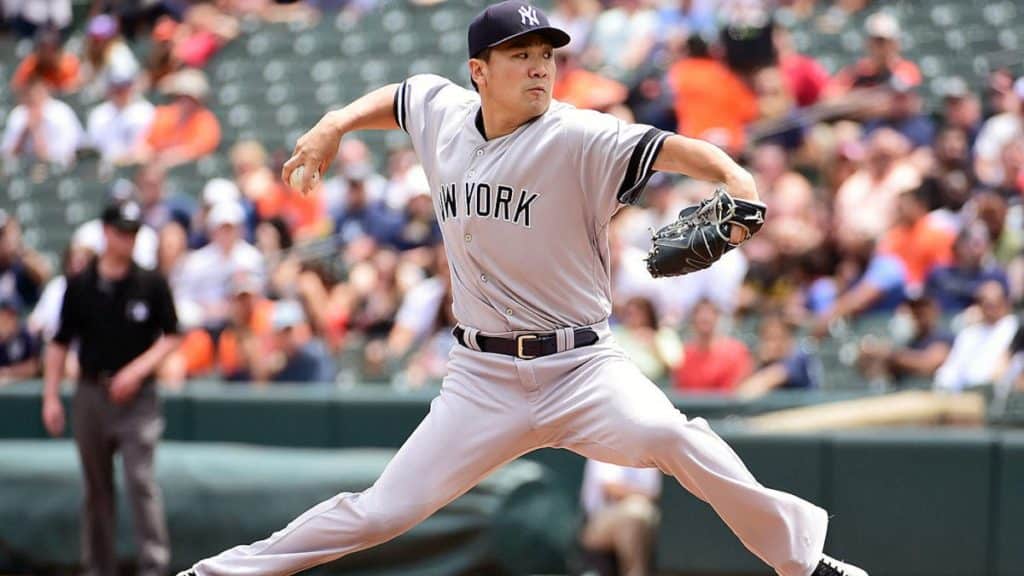
Famous for his split-finger fastball, Tanaka garnered one of the largest contracts for a Japanese player all-time when he signed a seven-year, $155 million contract with the New York Yankees. Compared to the other starting pitchers on this list, Tanaka’s career stats line up fairly close with the rest of them.
But what separates Tanaka is his playoff pedigree. After the 2019 playoffs, Tanaka became the first pitcher ever to allow two or fewer runs in his first seven Postseason starts. Who was he tied with at six Postseason starts and two or fewer runs allowed? Sandy Koufax. Adding to that, Tanaka has the second-lowest ERA (1.76) among Yankees pitchers to have at least 40 Postseason innings. Who’s number one on that list? Mariano Rivera with a 0.70 ERA. Keeping postseason company with two all-time great Hall of Famers is why he is this high on this list.
4. Hideki Matsui (New York Yankees 2003-09; Los Angeles Angels of Anaheim 2010; Oakland Athletics 2011; Tampa Bay Rays 2012)
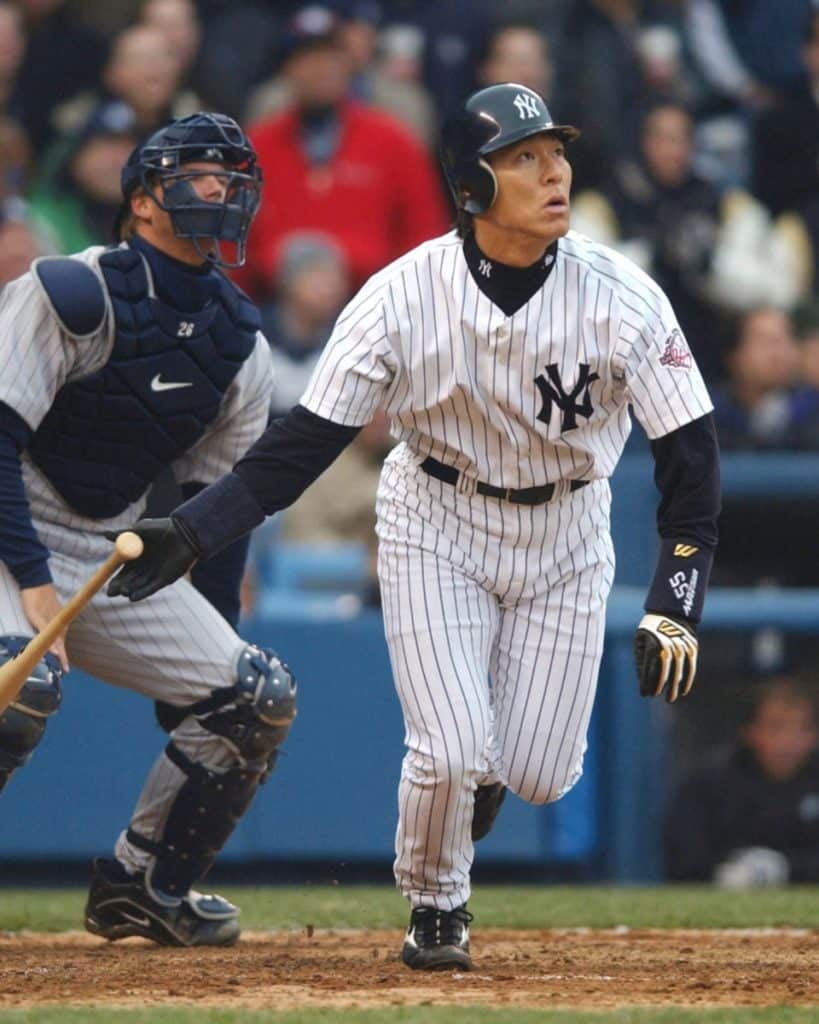
With the nickname Godzilla, Matsui was destined for greatness in the Big Apple. In his first Major League at-bat, Matsui roped an RBI single. A few games later at the Yankees’ 2003 home opener, he became the first Yankee to hit a grand slam in his first game at the Stadium. Matsui also has strong ties to Yankee great Lou Gehrig. To begin his career, Matsui didn’t miss a game in his first three seasons. His consecutive games streak lasted until the 31st game of his fourth season, when he fractured his wrist attempting to make a sliding catch. Matsui’s 518 consecutive games played to start a career is still a record.
Additionally, Matsui drove in seven runs at Fenway Park in 2009, the first Yankee to accomplish the feat since Gehrig did in 1930. Later that year, his last year as a Yankee, Matsui had one of the best sendoffs one could ask for: winning a World Series ring and World Series MVP, while slashing .615/.643/1.385 with eight RBI and three home runs. Matsui was also the first Japanese player to hit a home run in the postseason and World Series.
3. Hideo Nomo (Los Angeles Dodgers 1995-98; New York Mets 1998; Milwaukee Brewers 1999; Detroit Tigers 2000; Boston Red Sox 2001; Los Angeles Dodgers 2002-04; Tampa Bay Devil Rays 2005; Kansas City Royals 2008)

Nomo may not have the career statistics some on this list do, but his peak numbers and significance to the game are hard to match. When Nomo debuted with the Dodgers in 1995, becoming the second Japanese player to play in the bigs (after Murakami nearly 30 years prior), he was an instant hit. Kids across the country began emulating his tornado-like windup. By the end of the 1995 season, Nomo won the N.L. Rookie of the Year, became an All-Star and led the N.L. in strikeouts (236) and shutouts (3). The following year, he accomplished a feat nobody thought would be possible: pitch a no-hitter in Coors Field. Four years later, with the Red Sox, he hurled his second no-hitter. Oddly enough, Nomo also was the first Japanese player to hit a home run. Without question, Nomo’s success blew the door down for future Japanese stars to play in the majors.
2. Shohei Ohtani (Los Angeles Angels 2018-present)

When the Hokkaido Nippon-Ham Fighters posted Ohtani after the 2017 season, he was the most sought-after Japanese player in history. Nearly every MLB team clamored for his rare two-way services. And it is clear he has already surpassed the clout he established in Japan with the numbers he put up in 2021 and throughout his time in MLB. Throughout the year, statistics and news outlets regularly used phrases like “First player since Babe Ruth to…” or “This hasn’t been done since the ‘dead ball’ era” or “This is the first time in MLB history.” That’s some heady stuff that can’t be overlooked.
I said last year, “give Ohtani a couple of years and he will be higher on this list.” Well, it turns out he did a couple of years’ worth of work in one. I contemplated moving him to the number one spot, and I believe one would have a strong argument for making him number one. But the longevity of Ichiro, for the moment, slightly outweighs Ohtani’s four years in the bigs. But I’m sure in a couple more years—which in Ohtani’s otherworldy time and space seems to be one—I’ll have to rethink this once again.
1. Ichiro Suzuki (Seattle Mariners 2001-2012; New York Yankees 2012-14; Miami Marlins 2015-17; Seattle Mariners 2018-2019)

I said last year this was a no-brainer. Not so much anymore. Ohtani is right on his heels. Ichiro took MLB by storm in 2001 by winning the A.L Rookie of the Year and A.L MVP (joining Fred Lynn as the only players to accomplish this). That year he led the A.L. in hits (242), stolen bases (56), and average (.352). But perhaps more importantly, Ichiro was the first position player from Japan to play in the majors.
Ichiro went on to collect 200-plus hits in 10-straight years (2001-2010) while being named an All-Star in each of those years. Over his 19-year MLB career, Ichiro compiled 3,089 hits. Combing those hits with the 1,278 he had in Japan, Ichiro well surpasses Pete Rose for most hits all-time. But perhaps the most unique stat Ichiro accumulated in his Major League career is his lifetime average. On his second day in the bigs, Ichiro was hitting .222. After his third game, it sat at .308. From then on, his lifetime average would never dip below .300. This is a rare instance where true stories might outweigh myth.
For more Japanese baseball features, check out JapanBall’s Articles and Features section!
3 comments
Where’s Daisuke Matsuzaka on this list?
He barely did not make the cut. He had some high highs, but was not consistent enough after making the jump to MLB to make our top 10. I think he would be higher on best Japanese pitchers ever list due to his entire body of work, starting in HS. He did make our list of best MLB seasons ever by Japanese pitchers though!
[…] delicious welcome dinner wasn’t the food but rather our special guest: Japanese pitching legend Masanori Murakami! “Mashi” pitched for the San Francisco Giants in the 1960s and was the first Asian and first […]